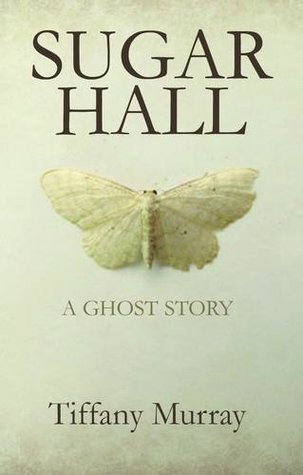 Sugar Hall: A Ghost Story by Tiffany Murray was some four years in the making. Given that the book is based on the stories of a ghost who haunted and continues to haunt Littledean Hall in the Forest of Dean (stories that the author first heard in the school playground when she was ‘a knock-kneed girl’) it seems fair to suggest the gestation period of Murray’s third novel was much longer.
Sugar Hall: A Ghost Story by Tiffany Murray was some four years in the making. Given that the book is based on the stories of a ghost who haunted and continues to haunt Littledean Hall in the Forest of Dean (stories that the author first heard in the school playground when she was ‘a knock-kneed girl’) it seems fair to suggest the gestation period of Murray’s third novel was much longer.
And it shows. Sugar Hall is a dazzlingly clever, superbly crafted book, demonstrating Murray’s dexterity as a storyteller; it is a classic ghost story furnished with a modern, stylish interior. What emerges is an exploration into our commonly held ideas of what a ghost is.
The story begins during the Easter holidays in 1955. Dieter Sugar, (‘the last Sugar’) the sole heir of Sugar Hall, a dilapatated country house near the Welsh borders, sees ‘the boy’, who is unlike ‘any other boy he’d seen before.’ Dieter returns home to his mother, Lilia, and sister, Saskia, to tell them of his encounter. The first piece of dialogue spoken in the book is a question (‘What is it, Dee?’ asks his mother) and this sets the tone for the rest of the novel as the characters, as will the reader, explore sins personal and historical, past and present, and the tragic flaws and traces of memory they leave behind.
Having left London following the death of his father, Dieter had left his friends behind him, ‘the Wee-Hoo Gang’, of which he was the leader. There, they had made an area they called the Wasteland their playground (a place that evokes T.S. Eliot’s ‘The Waste Land’) with ‘the smog came in from the Thames and the cranes that were building, building, building chugged in the distance.’ And it is not only Dieter that is affected by the move. London had afforded the Sugar family an anonymity that the verdant landscape surrounding Sugar Hall forces them to confront; their new residence is anything but a country retreat, and Lilia longs for the ‘noise of London’ as ‘it had drowned out so much.’
The friendship that develops between Dieter and the boy ‘who wears a silver collar’ symbolises the former’s continuing struggle to create meaningful relationships at Sugar Hall. Sugar Hall knowingly draws comparisons with Jane Ayre and Wuthering Heights (both are referenced in the novel), but Dieter’s relationship with the mysterious boy who appears ‘out of thin air’ finds a more rewarding parallel in the friendship between Antoinette and Tia in Jean Rhys’ Wide Sargasso Sea.
Except for a silver collar, the boy had appeared naked to Dieter. He then has the idea to give his dead father’s shirt and trousers to wear. When the boy appears a second time, amid the ‘dust dancing and cobwebs pulsing’, Dieter sees that he has no body beneath his face. ‘Who are you?’ asks Dieter. The boy does not speak. Instead he performs a movement that makes the bones in his neck click and pop, and the sound makes Dieter’s chin fall to his chest where ‘his nose dropped splashes of blood onto his father’s white shirt.’ In Wide Sargasso Sea, as Antoinette’s house in Coulibri burns, she sees Tia and runs for her, ‘for she was all that was left of my life as it had been. We had eaten the same food, slept side by side, bathed in the same river.’ When Antoinette catches up with Tia she sees the ‘jagged stone’ in her hand, but does not see her throw it, she feels ‘only something wet, running down my face…we stared at each other, blood on my face, tears on hers. It was as if I saw myself. Like in a looking-glass.’
Sugar Hall is sophisticatedly layered and lends itself to multiple interpretations. But the above-mentioned comparison is important because it is an explicit marker of the Lacanian concept of the mirror stage in psychoanalytic theory. Similarly, it is possible to draw reference to Freud’s concept of The Uncanny. For instance, is the boy Dieter encounters dead or alive? Is he a figment of Dieter’s imagination, a mechanism that allows him to cope with the untimely death of his father? Like Antoinette and Tia, the comfort Dieter takes in the boy’s presence throughout the novel suggests that he can only self-identify through him.
At times there is a sexual complicated rivalry between Dieter and the boy. As the latter becomes less benevolent and more of a threat – a classic motif of the döppelganger – he visits Dieter in the room he shares with his mother and sister. The boy climbs on top of his Lilia’s chest, ‘I must kiss her properly’, he says, and Dieter, seemingly paralysed, watches as ‘his face moved closer to hers.’ Fittingly, Murray uses an epigraph at the beginning of the novel, an extract from a poem by Kamau Brathwaite, entitled ‘Limbo’:
And the limbo stick is the silence in front of me / limbo / limbo / limbo like me
Its inclusion, of course, adds a dimension to the book as a whole, and complements the wonderful illustrations by Mexican artist, Eme De Amario. However, in this particular instance, ‘Limbo’ brings to mind Dieter’s indeterminate state, one that results rom the inability to fully identify with ‘Pa’, his dead father. ‘Come here and kiss her,’ says the boy to Dieter as he leans over his sleeping mother Lilia. His face clammy with sweat. In a scene that recalls the King Oedipus myth, Dieter then sees that ‘the boy’s eyes weren’t black or brown or blue or green or bright with gold anymore, they weren’t even eyes.’
The mysterious boy is, like any ghost, a reminder of loss. His appearance at Sugar Hall is the tipping point. Memories and histories from the darkest recesses of the minds and pasts of the characters and landscapes are brought to the boil. Sugar Hall is aptly named as it was built from the revenues of sugar cane plantations operating under slave labour conditions in the Carribean. Dieter’s mum, Lilia, escaped to England from Germany when she was only fifteen years old. Her personal traumas, born not only out of past ordeals but out of an intensity of will that is unique to those living in imposed exile, are discernable in her single-mindedness. As the third person narration shifts from character to character, each one revealing their own secret history of Sugar Hall, events build to an crescendo and culminate with an unforgetable conclusion.
Tantalisingly paced and elaborate in scope, Murray’s narrative patterning is very clever. Like Delillo and Ellroy, real life events intersperse the action of Sugar Hall and sometimes dictate and intensify it (the execution of Ruth Ellis is one brilliant example). If you want to read a book by a writer who knows exactly what she is writing about and has written it fabulously, read Sugar Hall.











